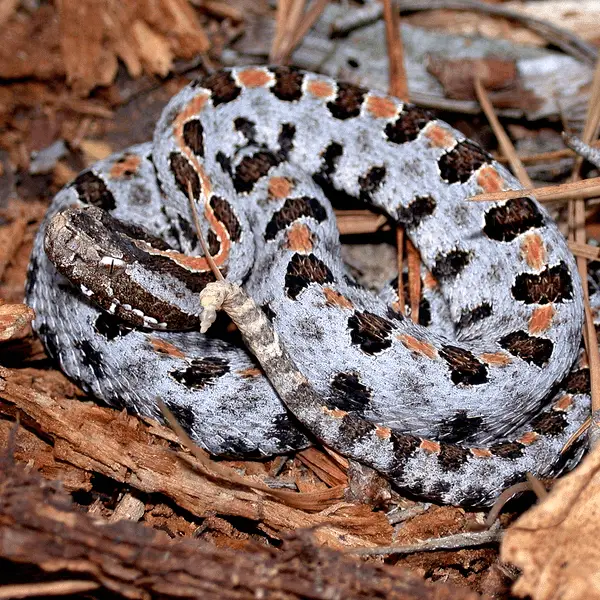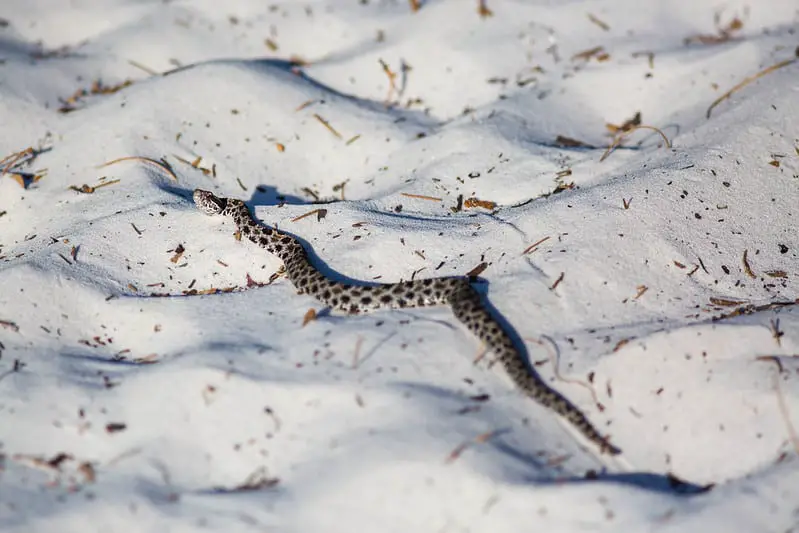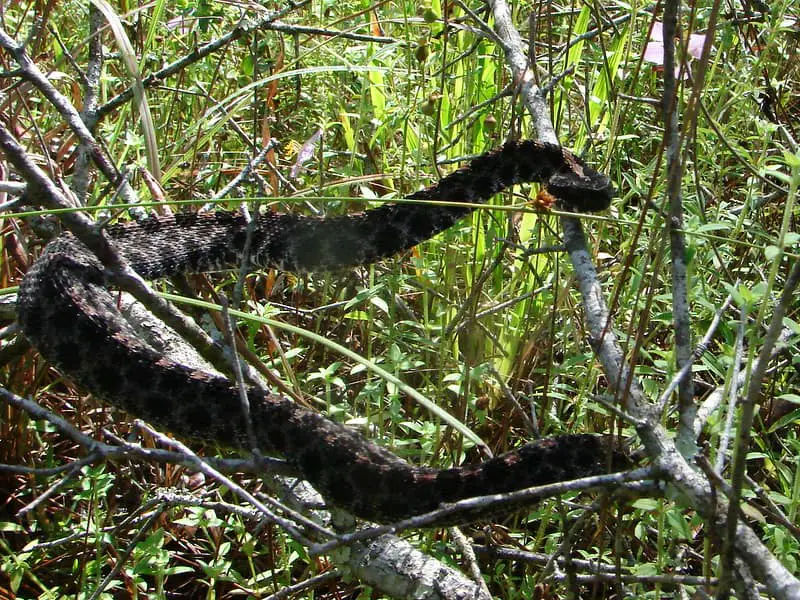The pygmy rattlesnake, Sistrurus miliarius, is a small venomous rattlesnake that can be found in the Southeastern United States. It reaches a size of up to 2 feet (60 cm) and has an overall grey, brown or blueish body color with a darker head and a row of dark spots along its back. Its bite can have significant medical effects but is not considered lethal.
Description
The basic coloration of the snake is light gray, gray, blueish grey or reddish with a pattern of small, roundish spots on the back, which are usually dark gray or black. In addition to the spots, the snake often has an orange stripe along its back. On the sides there are often further, smaller spots.
Its common name is not due to its body size, but because of its very small rattle in comparison to “real” rattlesnakes of the genus Crotalus.

Various nonvenomous snakes mimic the appearance and behavior of rattlesnakes. The western gopher snake as well as the western hognose snakes are examples for this and are sometimes confused with the pygmy ratatlesnake or other rattlesnakes.
Size
The pygmy rattlesnake is a small rattlesnake. Adults reach a body length (including tail) of 16-24 inches (40-60 cm). Only few specimen grow up to a maximum of 32 inches (80 cm). It is therefore smaller than its close relative, the massasauga rattlesnake.

Hunting Behavior
In contrast to its usually bigger rattlesnake relatives, the pygmy rattlesnake feeds mostly on lizards and amphibians. Only very rarely does it feed from young birds or small mammals.
Like other rattlesnakes, their main hunting routine is by lurking. After having found a suitable place, they will wait until an appropriate prey animal passes. They perceive and localize the prey with the sensory organs of the head. When attacking, the snake pushes the front body forward and opens its mouth. Its fangs are folded out and then hit the prey. After the bite, the snake usually holds on to the small prey animals since lizards don’t leave a heat-track that the snake could pursue.
Bite and Venom
As all its relatives, the pygmy rattlesnake is a venomous snake. Even though its venom is less potent than that of most other rattlesnakes and generally not considered lethal, a bite should always be treated by a medical professional with antivenom. A bite can lead to severe pain followed by internal bleeding, nausea and other symptoms. The bitten area will often swell and the tissue can be permanently damaged (necrosis) – especially without immediate medical attention.
The sanke uses its rattle as a warning mechanism when someone or something approaches too closely. However, the sound of its small rattle reminds more of the sound of insects than that of a rattlesnake and is often overheard. With any further approach, the snake will feel threatened and will strike quickly. Young snakes are especially dangerous, because they cannot yet or not sufficiently warn by rattling. Most of the time, they also inject the entire amount of venom in one bite in the absence of experience.
It is important to know that the distance at which this snake can strike is about half of its size. So if you keep a distance of around 3 feet (1 m), you are not in striking distance. Generally, we don’t recommend approaching too close to wild snakes.
Habitat
It lives in low-lying pine and oak forests with a sandy underground. But also at the edge of swamps and rivers as well as in dry, but also humid prairies with a high grass growth.

Pygmy rattlesnake range in the USA
The pygmy rattlesnake can be found thoughout the Southeastern United States. More precisely in East Texas, Eastern Oklahoma, Louisiana, Arkansas, South Missouri, Mississippi, Alabama, Georgia, Florida, South Carolina, North Carolina, and Western Tennessee.
Subspecies of Sistrurus miliarius
Currently, three subspecies of the pygmy rattlesnake are distinguished:
- Sistrurus miliarius barbouri or Dusky pygmy rattlesnake in Florida, southern Georgia and Alabama and the extreme southeast of the state of Mississippi; this species is characterized by fine speckles on the body and head
- Sistrurus miliarius miliaris or Carolina pygmy rattlesnake in North and South Carolina, central Georgia and Alabama
- Sistrurus miliarius streckeri or western pygmy rattlesnake in the westernmost part of the distribution area up to the Atlantic coast.
Scientific classification of Sistrurus miliarius
- Kingdom: Animalia
- Phylum: Chordata
- Class: Reptilia
- Order: Squamata
- Suborder: Serpentes
- Family: Viperidae
- Genus: Sistrurus
- Species: Sistrurus miliarius
Other common names
The pygmy rattlesnake is known under several other common names. Some of them are ground rattlesnake, hog-nosed rattlesnake, little rattlesnake, miliary rattlesnake, North American smaller rattlesnake, oak-leaf rattler, spotted rattler, southern rattlesnake.